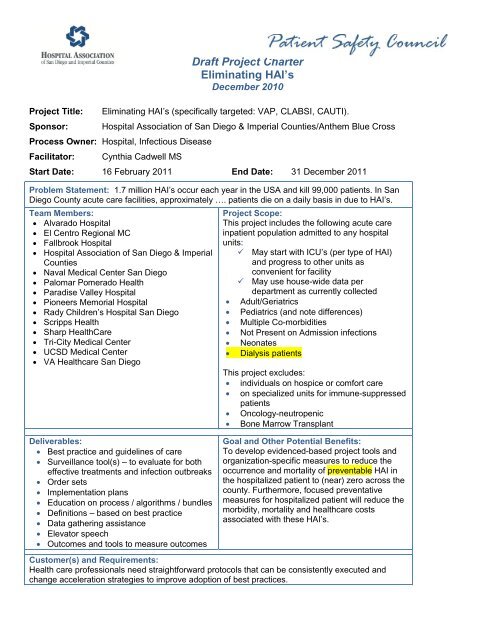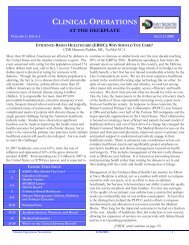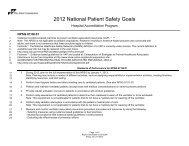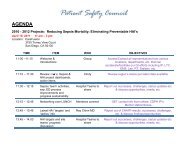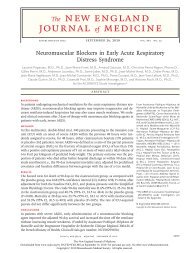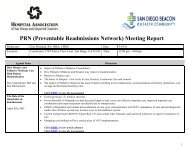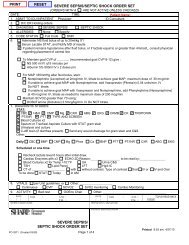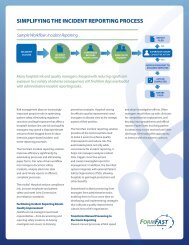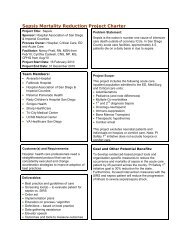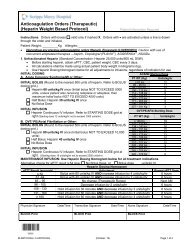Draft Project Charter Eliminating HAI's - Patientsafetycouncil.org
Draft Project Charter Eliminating HAI's - Patientsafetycouncil.org
Draft Project Charter Eliminating HAI's - Patientsafetycouncil.org
Create successful ePaper yourself
Turn your PDF publications into a flip-book with our unique Google optimized e-Paper software.
<strong>Project</strong> Title:<br />
Sponsor:<br />
<strong>Draft</strong> <strong>Project</strong> <strong>Charter</strong><br />
<strong>Eliminating</strong> HAI’s<br />
December 2010<br />
<strong>Eliminating</strong> HAI’s (specifically targeted: VAP, CLABSI, CAUTI).<br />
Hospital Association of San Diego & Imperial Counties/Anthem Blue Cross<br />
Process Owner: Hospital, Infectious Disease<br />
Facilitator:<br />
Cynthia Cadwell MS<br />
Start Date: 16 February 2011 End Date: 31 December 2011<br />
Problem Statement: 1.7 million HAI’s occur each year in the USA and kill 99,000 patients. In San<br />
Diego County acute care facilities, approximately …. patients die on a daily basis in due to HAI’s.<br />
Team Members:<br />
• Alvarado Hospital<br />
• El Centro Regional MC<br />
• Fallbrook Hospital<br />
• Hospital Association of San Diego & Imperial<br />
Counties<br />
• Naval Medical Center San Diego<br />
• Palomar Pomerado Health<br />
• Paradise Valley Hospital<br />
• Pioneers Memorial Hospital<br />
• Rady Children’s Hospital San Diego<br />
• Scripps Health<br />
• Sharp HealthCare<br />
• Tri-City Medical Center<br />
• UCSD Medical Center<br />
• VA Healthcare San Diego<br />
<strong>Project</strong> Scope:<br />
This project includes the following acute care<br />
inpatient population admitted to any hospital<br />
units:<br />
May start with ICU’s (per type of HAI)<br />
and progress to other units as<br />
convenient for facility<br />
May use house-wide data per<br />
department as currently collected<br />
• Adult/Geriatrics<br />
• Pediatrics (and note differences)<br />
• Multiple Co-morbidities<br />
• Not Present on Admission infections<br />
• Neonates<br />
• Dialysis patients<br />
This project excludes:<br />
• individuals on hospice or comfort care<br />
• on specialized units for immune-suppressed<br />
patients<br />
• Oncology-neutropenic<br />
• Bone Marrow Transplant<br />
Deliverables:<br />
• Best practice and guidelines of care<br />
• Surveillance tool(s) – to evaluate for both<br />
effective treatments and infection outbreaks<br />
• Order sets<br />
• Implementation plans<br />
• Education on process / algorithms / bundles<br />
• Definitions – based on best practice<br />
• Data gathering assistance<br />
• Elevator speech<br />
• Outcomes and tools to measure outcomes<br />
Goal and Other Potential Benefits:<br />
To develop evidenced-based project tools and<br />
<strong>org</strong>anization-specific measures to reduce the<br />
occurrence and mortality of preventable HAI in<br />
the hospitalized patient to (near) zero across the<br />
county. Furthermore, focused preventative<br />
measures for hospitalized patient will reduce the<br />
morbidity, mortality and healthcare costs<br />
associated with these HAI’s.<br />
Customer(s) and Requirements:<br />
Health care professionals need straightforward protocols that can be consistently executed and<br />
change acceleration strategies to improve adoption of best practices.
Population<br />
Preventing HAI’s can reduce patient progressing to morbidity, increased LOS and death<br />
Coding based on MD diagnosis HAI (use any available codes for VAP, CLABSI & CAUTI)<br />
C Diff may an HAI of interest to ‘further’ target<br />
Dioalysis patients may be a target that could have significant benefit<br />
• Most MDs identify infection but not necessarily HA<br />
• Providers not aware of documenting POA infections<br />
• Patient admitted into hospital without infection?<br />
• N = all patients with ‘preventable’ HAI (VAP, CLABSI, CAUTI)<br />
• D = device days/1000 (as per NHSN standard reporting)<br />
Goal<br />
• Reduce the incidence of HAI’s in the acute care patient to near zero across the county;<br />
• Need current number – administrative data – for Not Present on Admission<br />
• Side goal: Reduce costs and LOS for patients requiring certain devices.<br />
• Each <strong>org</strong>anization: rate of VAP, CLABSI, CAUTI not POA<br />
How can this project help us at our facility?<br />
• Implementation tools, ideas and methods sharing can accelerate change and impact<br />
Elevator Speech<br />
Recommend producing an elevator speech for each target audience.<br />
• What our project is about… prevention of the HAI’s (VAP, CLABSI & CAUTI and/or C Diff) to near zero in<br />
our region, as well as improving overall patient outcomes.<br />
• Why it is important to do… because HAI’s are preventable with appropriate intervention, yet today it<br />
occurs in about 1.7million per year in the US, killing 99K. That’s …. patients getting HAI’s in our region per<br />
day, and … dying from them.<br />
• What success will look like… increased regional compliance with evidenced-based best practices<br />
resulting in zero ‘preventable’ HAI’s, and institutions realizing an overall decrease in patient hospital stay<br />
and costs.<br />
• What we need from you… a commitment to understand, support, and comply with best practices to<br />
prevent HAI’s including early identification of high-risk patients, collaborating with colleagues, and providing<br />
best possible data and classification of HAI’s.<br />
Staging <strong>Project</strong><br />
Considering evidence available it’s clear what needs to be done…<br />
Timeline<br />
Description<br />
Feb 2011 • Where are we now with CLABSI, VAP and CAUTI<br />
• How to prevent HAI’s?<br />
• Literature and Tools available<br />
• Are C-Diff and SSI’s important to us? How does antibiotic stewardship play a role?<br />
April 2011 • HAI prevention campaigns<br />
• Order sets available in most facilities<br />
• Change management/Implementation<br />
June 2011 • Prevention and surveillance methods, tools and resources<br />
August 2011 • Finalize Toolkit<br />
• Review change management<br />
October 2011 • Measurement of progress<br />
• Stakeholder analysis<br />
December 2011 • <strong>Project</strong> status evaluation


